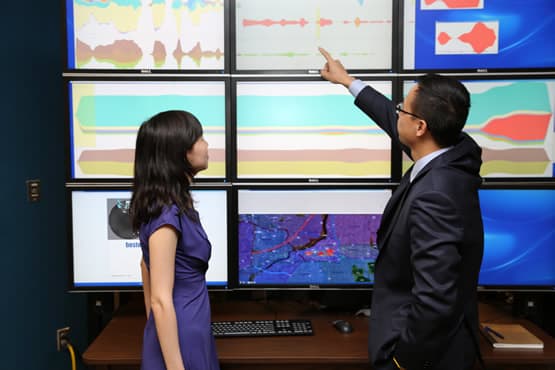
Twitter and Facebook are popular social media tools for communication, and for researchers in the College of Computing and Informatics (CCI) Charlotte Visualization Center, they are providing key insights into consumer behavior.
Eight faculty members from CCI and the Belk College of Business have been looking at social media and what information can be extracted about customer behavior or potential customer behavior, according to William Ribarsky, chair of the Department of Computer Science and director of the Charlotte Visualization Center.
“By looking at Twitter and Facebook streams we can determine how people respond to marketing or ad campaigns, what they think about companies, how they talk amongst themselves about companies, etc.,” Ribarsky stated.
He noted that with Twitter, researchers can follow how ideas are spread through re-tweeting. It’s an implicit social network where information is passed along, he said, adding that by studying this process one can determine how things can go viral.
“There is an actual social network structure,” stated Ribarsky. “We look at what people are talking about, but it’s not like trending. Rather, we evaluate the stream and let it tell us about what is going on. This is a very useful tool if you have unexpected things happening. You actually can see events as they are occurring or before they occur and do predictive or forensic analysis.”
Ribarsky said a perfect example of this is when Xiaoyu Wang, associate director of the Charlotte Visualization Center, did a forensic analysis on Occupy Wall Street tracing back to the dates before it happened. This analysis showed that if the tool developed here had been available, the start and form of Occupy Wall Street could have been predicted some weeks before its launch.
This predictive analytics tool, Wang stated, is a new and very powerful way of allowing businesses to figure out what customers are thinking and what they may do. It provides up-to-the-minute data analysis, and offers business owners the ability to pin point market trends and patterns.
Talks are currently ongoing with Belk Inc., Bank of America, Lowe’s and Family Dollar to see how these tools might be of value to them in their marketing efforts.
“By monitoring other stores in the area and doing analysis on what people are saying about their advertising campaigns it could provide very valuable information for counter advertising strategies,” said Ribarsky. “We can now see the information derived from the Twitter stream in near real time and have the ability to analyze and turn it around in five minutes or so. This would allow folks to take advantage of trends as they are unfolding. We can determine, for example, that people are going to the mall even before they get there.”
Using the tools developed by Wang and his colleague Wenwen Dou, assistant research professor in the Department of Computer Science, the center is now sifting through millions of tweets every day, in near real time, for emerging events and event indicators.
Wang stated, “We will be able to track trends of what people may be looking for and allow retailers to counter immediately with special sales and the like.”
Ribarsky said Twitter allows his research team to look at one percent of its traffic for free. For anything more there is a fee. But, he is quick to point out that one percent is a considerable amount of data. The team is now extending these techniques to Facebook, where they retrieve public facing pages and extract the information they are looking for. The team also has the ability to do similar analytical analyses on non-social media information supplied by companies.
“The college and the Charlotte Visualization Center are in the front and center, with support from the University, to unlock the key to big-data customer analytics,” said Wang.